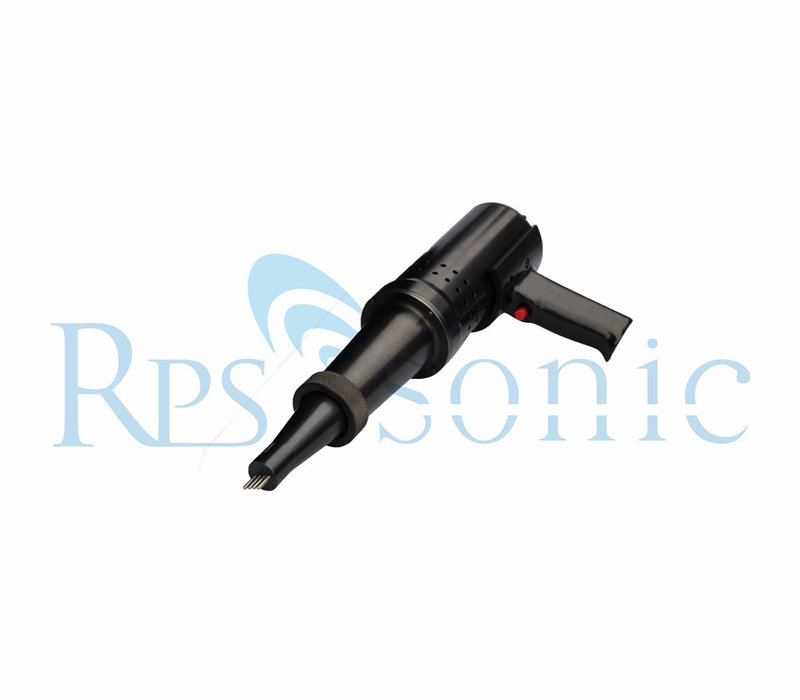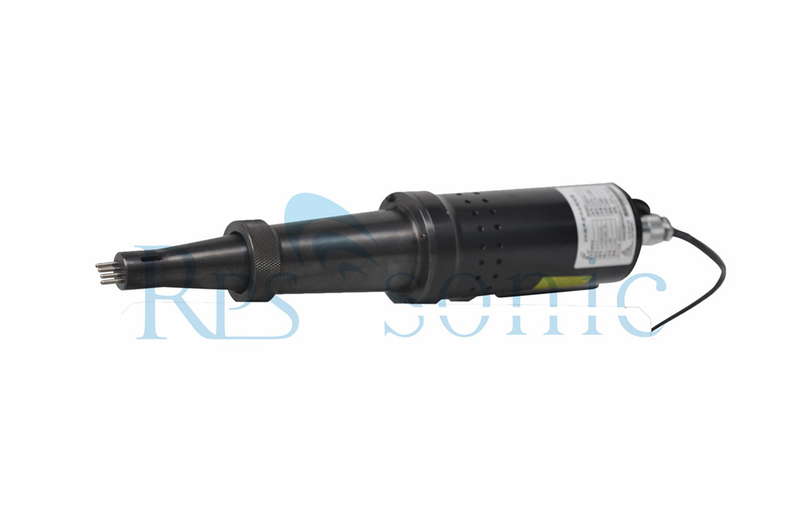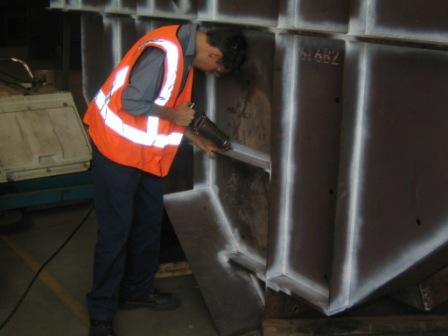- All
- Product Name
- Product Keyword
- Product Model
- Product Summary
- Product Description
- Multi Field Search
What is ultrasonic tinning?Ultrasonic tinning is a kind of welding method that does not use flux. The ultrasonic probe produces cavitation in the molten solder core through mechanical vibration at ultrasonic frequency, and removes the oxide film on the metal surface for smooth and clean tinning. Ult
What is ultrasonic tinning?Ultrasonic tinning is a kind of welding method that does not use flux. The ultrasonic probe produces cavitation in the molten solder core through mechanical vibration at ultrasonic frequency, and removes the oxide film on the metal surface for smooth and clean tinning. Ult
The application of ultrasonic in the sewing industry mainly reflects the two major functions of ultrasonic: welding and cutting. In 2019, for masks that are popular all over the world, ultrasound is a household name for applying these two functions to the fullest. The cutting and welding of velvet c
What is Diesel Water Emulsion?To best understand what a diesel water emulsion is, we first must discuss the process of emulsifying liquids. Chemically speaking, an emulsified liquid, also known as a dispersion, is a liquid in which distributed particles of one material are dispersed in another mater
What is Diesel Water Emulsion?To best understand what a diesel water emulsion is, we first must discuss the process of emulsifying liquids. Chemically speaking, an emulsified liquid, also known as a dispersion, is a liquid in which distributed particles of one material are dispersed in another mater
Ultrasound atomization technology is an efficient and low-cost method for producing fine metal powders. The powders produced using this method have good sphericity, controllable particle size, and a narrow size distribution, making it a promising technology in the metal powder industry. Ultrasound m
Type of PumpsAccording to the working principle and structure of the pump, there are several types of pumps:
Type of PumpsAccording to the working principle and structure of the pump, there are several types of pumps:
What is Diesel Water Emulsion?To best understand what a diesel water emulsion is, we first must discuss the process of emulsifying liquids. Chemically speaking, an emulsified liquid, also known as a dispersion, is a liquid in which distributed particles of one material are dispersed in another mater
Ultrasonic extraction, also known as sonication, is a powerful technique that harnesses the energy of high-frequency sound waves to extract valuable compounds from various natural sources. This non-invasive and environmentally friendly method has gained significant attention in recent years due to i
Ultrasonic emulsification results in significantly smaller droplets and better emulsion stability. Ultrasonic nano-emulsification is used to produce high-performance emulsions for high-performance materials, paints, coatings, food, pharma, and cosmetics. Organic and inorganic pigments are an importa
Ultrasonic spray coating system is a technique for forming thin films with specific functions or properties on the surface of optical glass. It utilizes ultrasonic waves to atomize liquid into fine droplets and uniformly spray them onto the surface of optical glass. This article introduces the princ
By Matthew Taylor, Associate Researcher & Writer at Save The Water™ | March 30, 2021 Not every water purification technology matches a given situation effectively. For example, their ability to remove some contaminants from water, their cost, and their capacity limit them. We need new technologies t
The use of ultrasonics is becoming increasingly important for the food industry.Ultrasound in Food Processing enables scientists, engineers andmanagers in food manufacturing to make informed choices about anew and important area of research and development. It will also be avaluable reference to peo
What is ultrasonic tinning?Ultrasonic tinning is a kind of welding method that does not use flux. The ultrasonic probe produces cavitation in the molten solder core through mechanical vibration at ultrasonic frequency, and removes the oxide film on the metal surface for smooth and clean tinning. Ult
Do you know? Every year, over 10 billion blood collection tubes and syringe barrels are produced and used worldwide, playing a crucial role in the diagnosis and treatment in the medical field. However, what you may not know is that the most critical step in the manufacturing process of these devices
Float glass is a widely used glass product in various fields. Its production process involves floating molten glass on a high-temperature tin bath to form a flat, smooth, and uniform glass ribbon. Float glass has advantages such as good optical properties, high transparency, and high surface quality
The application of ultrasonic in the sewing industry mainly reflects the two major functions of ultrasonic: welding and cutting. In 2019, for masks that are popular all over the world, ultrasound is a household name for applying these two functions to the fullest. The cutting and welding of velvet c
what's the ultrasonic ? what's the ultrasonic extractor technology? the essay will introduce the ultrasonic and ultrasonic extraction techolgy from many aspects.
Ultrasonic spraying, also known as ultrasonic spraying, is a spraying process using ultrasonic atomization technology. The sprayed material is first in a liquid state. The liquid can be a solution, sol, suspension, etc. The liquid coating is first atomized into fine particles by an ultrasonic atomiz
| Frequency: | |
|---|---|
| Amplitude of vibration (a): | |
| Power: | |
| Availability: | |
| Quantity: | |


UIT20
Rps-sonic
UIT20
What's is ultrasonic impact treatment
Ultrasonic impact treatment (UIT) is a relatively novel technique applied to the toe of welded joints to improve the fatigue life by changing the weld geometry and the residual stress state. In this study, the stress relaxation due to ultrasonic impact treatment is investigated on a six pass welded high strength quenched and tempered steel section. Stress measurements in two orthogonal directions were conducted by energy dispersive synchrotron X-ray diffraction. Results show that the application of only ultrasound to a welded component re-distributes the residual stresses more uniformly, while mechanical impacts in combination with ultrasound is an effective way to release the residual stresses. After welding, diffraction peak broadening due to the lattice distortion, characterised by the full width at half maximum (FWHM), is observed in the region of the weld toes. Ultrasonic impact treatment reduces the FWHM at these locations.
Shot Peening Equipment by Ultrasonic Impact Treatment technology allows the use of high quality media. Quality madia combined to the real-time control of parameters, ensures a repeatable and efficient treatment. Ultrasonic Shot Peening (USP) induces a low roughness and a better surface quality compared to the conventional shot peening. This has a direct influence on fatigue-life enhancement and prevent Stress Corrosion Cracking.
Parameter:
| Model No. | UIT20 | |
| Ultrasonic Frequency | 20Khz | |
| Maximum Output | 800 Watt | |
| Amplitude | 40um | |
| Power Supply | 220V / 50-60 Hz | |
| Ultrasonic Generator | Size | 250(W) x 310(L) x 135(H) mm |
| Weight | 5 Kg | |
| Feature | Ultrasonic Amplitude Adjustable | |
Application:
Inscreasing productivity and quality
Cost reductions
Improving fatigue life
Treatment of complex geometry parts
Process control and repeatability
Low roughness (see image above)
Shorter treatment cycle time
Reducing consumption of beads, energy and compressed air
Integration in the production line (lean manufacturing)

What's is ultrasonic impact treatment
Ultrasonic impact treatment (UIT) is a relatively novel technique applied to the toe of welded joints to improve the fatigue life by changing the weld geometry and the residual stress state. In this study, the stress relaxation due to ultrasonic impact treatment is investigated on a six pass welded high strength quenched and tempered steel section. Stress measurements in two orthogonal directions were conducted by energy dispersive synchrotron X-ray diffraction. Results show that the application of only ultrasound to a welded component re-distributes the residual stresses more uniformly, while mechanical impacts in combination with ultrasound is an effective way to release the residual stresses. After welding, diffraction peak broadening due to the lattice distortion, characterised by the full width at half maximum (FWHM), is observed in the region of the weld toes. Ultrasonic impact treatment reduces the FWHM at these locations.
Shot Peening Equipment by Ultrasonic Impact Treatment technology allows the use of high quality media. Quality madia combined to the real-time control of parameters, ensures a repeatable and efficient treatment. Ultrasonic Shot Peening (USP) induces a low roughness and a better surface quality compared to the conventional shot peening. This has a direct influence on fatigue-life enhancement and prevent Stress Corrosion Cracking.
Parameter:
| Model No. | UIT20 | |
| Ultrasonic Frequency | 20Khz | |
| Maximum Output | 800 Watt | |
| Amplitude | 40um | |
| Power Supply | 220V / 50-60 Hz | |
| Ultrasonic Generator | Size | 250(W) x 310(L) x 135(H) mm |
| Weight | 5 Kg | |
| Feature | Ultrasonic Amplitude Adjustable | |
Application:
Inscreasing productivity and quality
Cost reductions
Improving fatigue life
Treatment of complex geometry parts
Process control and repeatability
Low roughness (see image above)
Shorter treatment cycle time
Reducing consumption of beads, energy and compressed air
Integration in the production line (lean manufacturing)

INCREASE IN STRESS CORROSION CRACKING (SCC) RESISTANCE
The creation of superficial compression, by peening, due to the impact of the needles on the material also makes it possible to improve the resistance for stress corrosion cracking.
As this phenomenon occurs on structures and assemblies exposed to corrosive environments, the HFMI/UIT process helps to delay or even eliminate the appearance of cracks.
CORRECTION OF DISTORSIONS DUE TO WELDING
The stresses created by welding processes cause distortions in the welds between the panels.
These well-known distortions occur during the cooling phase of the weld, when the molten metal shrinks, resulting in plastic deformation of the welded metals.
In order to eliminate tensile stress, conventional stress relieving processes are currently applied locally (heating, TIG dressing, etc.). These processes restore a stress level close to 0 MPa at the surface and at a depth but do not correct the defect created by the weld.
The ultrasonic impact treatment (HFMI / UIT) process not only allows to create residual compressive stresses, which are much more beneficial than stress relief but also allows to straighten the deformations caused by welding. The 2 in 1 effect of ultrasonic impact treatment (HFMI / UIT) is particularly valuable when the aim is to improve the fatigue strength of steels, aluminium and other metal alloys while correcting geometrical defects.
FOR BOTH CURATIVE AND PREVENTIVE TREATMENT
When producing a part or making and assembling a structure, the first step in controlling fatigue resistance is to assess the most critical areas where cracks may appear. Then the best process to apply must be determined. The key to this choice is to assess whether a method of improving fatigue resistance is needed before the onset of major damage. A preventative rather than a corrective approach is much better in order to minimise costs and maximise profits.
Ultrasonic impact treatment is one of the best preventive treatments to improve the fatigue resistance of welded structures
INCREASE IN STRESS CORROSION CRACKING (SCC) RESISTANCE
The creation of superficial compression, by peening, due to the impact of the needles on the material also makes it possible to improve the resistance for stress corrosion cracking.
As this phenomenon occurs on structures and assemblies exposed to corrosive environments, the HFMI/UIT process helps to delay or even eliminate the appearance of cracks.
CORRECTION OF DISTORSIONS DUE TO WELDING
The stresses created by welding processes cause distortions in the welds between the panels.
These well-known distortions occur during the cooling phase of the weld, when the molten metal shrinks, resulting in plastic deformation of the welded metals.
In order to eliminate tensile stress, conventional stress relieving processes are currently applied locally (heating, TIG dressing, etc.). These processes restore a stress level close to 0 MPa at the surface and at a depth but do not correct the defect created by the weld.
The ultrasonic impact treatment (HFMI / UIT) process not only allows to create residual compressive stresses, which are much more beneficial than stress relief but also allows to straighten the deformations caused by welding. The 2 in 1 effect of ultrasonic impact treatment (HFMI / UIT) is particularly valuable when the aim is to improve the fatigue strength of steels, aluminium and other metal alloys while correcting geometrical defects.
FOR BOTH CURATIVE AND PREVENTIVE TREATMENT
When producing a part or making and assembling a structure, the first step in controlling fatigue resistance is to assess the most critical areas where cracks may appear. Then the best process to apply must be determined. The key to this choice is to assess whether a method of improving fatigue resistance is needed before the onset of major damage. A preventative rather than a corrective approach is much better in order to minimise costs and maximise profits.
Ultrasonic impact treatment is one of the best preventive treatments to improve the fatigue resistance of welded structures
The UP could be effectively applied for fatigue life improvement during manufacturing, rehabilitation and repair of welded elements and structures. The UP technology and equipment were successfully applied in different industrial projects for rehabilitation and weld repair of parts and welded elements. The areas/industries where the UP was applied successfully include: Railway and Highway Bridges, Construction Equipment, Shipbuilding, Mining, Automotive and Aerospace. An example of application of UP for repair and rehabilitation of welded elements subjected to fatigue loading in mining industry is shown in Figure 7. Around 300 meters of welds, critical from fatigue point of view, were UP treated to provide improved fatigue performance of large grinding mills.
Application of UP for rehabilitation of welded elements of a large grinding mill
Based on the fatigue data and the solution described in [10], the UP was also applied during the rehabilitation of welded elements of a highway bridge over the Ohio River in the USA.
The bridge was constructed about 30 years ago. The welded details of the bridge did not have macroscopic fatigue cracks. The motivation for application of the UP for fatigue life improvement of this bridge was the fatigue cracking in welded elements and failure of one of the spans of another bridge of approximately the same age and design. The stages of preparation for UP treatment of the bridge and the process of UP treatment of one of the welded vertical stiffeners are shown in Figures 8 and 9. More than two thousand and five hundred welded details of the bridge structure that were considered to be fatigue critical were UP treated.
The UP could be effectively applied for fatigue life improvement during manufacturing, rehabilitation and repair of welded elements and structures. The UP technology and equipment were successfully applied in different industrial projects for rehabilitation and weld repair of parts and welded elements. The areas/industries where the UP was applied successfully include: Railway and Highway Bridges, Construction Equipment, Shipbuilding, Mining, Automotive and Aerospace. An example of application of UP for repair and rehabilitation of welded elements subjected to fatigue loading in mining industry is shown in Figure 7. Around 300 meters of welds, critical from fatigue point of view, were UP treated to provide improved fatigue performance of large grinding mills.
Application of UP for rehabilitation of welded elements of a large grinding mill
Based on the fatigue data and the solution described in [10], the UP was also applied during the rehabilitation of welded elements of a highway bridge over the Ohio River in the USA.
The bridge was constructed about 30 years ago. The welded details of the bridge did not have macroscopic fatigue cracks. The motivation for application of the UP for fatigue life improvement of this bridge was the fatigue cracking in welded elements and failure of one of the spans of another bridge of approximately the same age and design. The stages of preparation for UP treatment of the bridge and the process of UP treatment of one of the welded vertical stiffeners are shown in Figures 8 and 9. More than two thousand and five hundred welded details of the bridge structure that were considered to be fatigue critical were UP treated.
Ms. Yvonne
sales@xingultrasonic.com
0086-15658151051
Room 1103B, Nature business building , NO.1160 GongWang Road ,FuYang, Hangzhou,Zhejiang,China